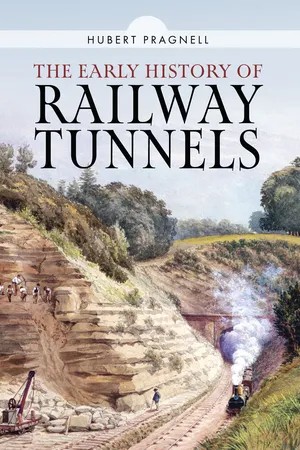
- 280 pages
- English
- ePUB (mobile friendly)
- Available on iOS & Android
The Early History of Railway Tunnels
About this book
To the early railway traveller, the prospect of travelling to places in hours rather than days hitherto was an inviting prospect, however a journey was not without its fears as well as excitement. To some, the prospect of travelling through a tunnel without carriage lighting, with smoke permeating the compartment and the confined noise was a horror of the new age. What might happen if we broke down or crashed into another train in the darkness? To others it was exciting, with the light from the footplate flickering against the tunnel walls or spotting the occasional glimpses of light from a ventilation shaft. To the directors of early railway companies, planning a route was governed by expense and the most direct way. Avoiding hills could add miles but tunnelling through them could involve vast expense as the Great Western Railway found at Box and the London and Birmingham at Kilsby. Creating a cutting as an alternative was also costly not only in labour and time, but also in compensation for landowners, who opposed railways on visual and social grounds having seen their land divided by canals. Construction involved millions of bricks or blocks of stone for sufficiently thick walls to withstand collapse. However, the entrance barely seen from the carriage window might be an impressive Italianate arch as at Primrose Hill, or a castellated portal worthy of the Middle Ages as at Bramhope. This book sets out to tell the story of tunnelling in Britain up to about 1870, when it was a question of burrowing through earth and rock with spade and explosive powder, with the constant danger of collapse or flooding leading to injury and death. It uses contemporary accounts, from the dangers of railway travel by Dickens to the excitement of being drawn through the Liverpool Wapping Tunnel by the young composer Mendelssoln. It includes descriptions from early railway company guide books, newspapers and diaries. It also includes numerous photographs and colored architectural elevations from railway archives.
Frequently asked questions
- Essential is ideal for learners and professionals who enjoy exploring a wide range of subjects. Access the Essential Library with 800,000+ trusted titles and best-sellers across business, personal growth, and the humanities. Includes unlimited reading time and Standard Read Aloud voice.
- Complete: Perfect for advanced learners and researchers needing full, unrestricted access. Unlock 1.4M+ books across hundreds of subjects, including academic and specialized titles. The Complete Plan also includes advanced features like Premium Read Aloud and Research Assistant.
Please note we cannot support devices running on iOS 13 and Android 7 or earlier. Learn more about using the app.
Information
Table of contents
- Cover
- Title
- Copyright
- Contents
- List of Illustrations
- Acknowledgements
- Chapter 1 Introduction: The Fascination of the Railway Tunnel
- Chapter 2 The Need for a Railway Tunnel and the Problems of Construction
- Chapter 3 A Railway, a Landowner and his Estate
- Chapter 4 The Fascination of Early Railway Tunnels
- Chapter 5 The Fear of a Railway Tunnel
- Chapter 6 Style and Taste: Unnecessary Splendour Classical or Castellated?
- Chapter 7 Postscript
- Glossary of Railway Companies and Abbreviations
- Appendix 1 Architectural Terminology
- Appendix 2 Tunnel Portals with Distinctive Architectural Character
- Appendix 3 Accidents in Tunnels 1830–70 reported to the Board of Trade or in the Press
- Appendix 4 Cost of Construction
- Bibliography
- Endnotes